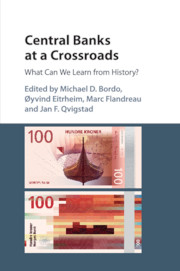Book contents
- Central Banks at a Crossroads
- Studies in Macroeconomic History
- Central Banks at a Crossroads
- Copyright page
- Contents
- Editors and contributors
- Preface
- 1 Introduction
- 2 The Descent of Central Banks (1400–1815)
- 3 Central Bank Credibility
- 4 The Coevolution of Money Markets and Monetary Policy, 1815–2008
- 5 Central Bank Independence in Small Open Economies
- 6 Fighting the Last War
- 7 A Century and a Half of Central Banks, International Reserves, and International Currencies
- 8 Central Banks and the Stability of the International Monetary Regime
- 9 The International Monetary and Financial System
- 10 Central Banking
- 11 The Evolution of the Financial Stability Mandate
- 12 Bubbles and Central Banks
- 13 Central Banks and Payment Systems
- 14 Central Bank Evolution
- 15 The Evolution of Central Banks
- Index
- Other books in the series (continued from page iv)
- References
2 - The Descent of Central Banks (1400–1815)
Published online by Cambridge University Press: 05 June 2016
- Central Banks at a Crossroads
- Studies in Macroeconomic History
- Central Banks at a Crossroads
- Copyright page
- Contents
- Editors and contributors
- Preface
- 1 Introduction
- 2 The Descent of Central Banks (1400–1815)
- 3 Central Bank Credibility
- 4 The Coevolution of Money Markets and Monetary Policy, 1815–2008
- 5 Central Bank Independence in Small Open Economies
- 6 Fighting the Last War
- 7 A Century and a Half of Central Banks, International Reserves, and International Currencies
- 8 Central Banks and the Stability of the International Monetary Regime
- 9 The International Monetary and Financial System
- 10 Central Banking
- 11 The Evolution of the Financial Stability Mandate
- 12 Bubbles and Central Banks
- 13 Central Banks and Payment Systems
- 14 Central Bank Evolution
- 15 The Evolution of Central Banks
- Index
- Other books in the series (continued from page iv)
- References
- Type
- Chapter
- Information
- Central Banks at a CrossroadsWhat Can We Learn from History?, pp. 18 - 61Publisher: Cambridge University PressPrint publication year: 2016
References
- 10
- Cited by

